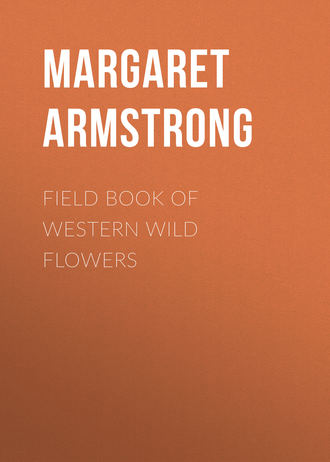 полная версия
полная версияField Book of Western Wild Flowers
Spring
Southwest and Col.
The leaves of this low, stout, and spreading perennial are an inch or two long, light bluish-green, somewhat heart-shaped, rather rough and coarse, and the stems are often hairy and sticky. The foliage contrasts strikingly in color with the gaudy pink or magenta flowers, an inch across and slightly sweet-scented, the shape of Morning-glories and resembling them, as they have the same stripes of deeper color. The long stamens droop to one side, the pistil is long and purple and the bell-shaped involucre contains about six flowers. These plants are conspicuous and quite handsome. They grow on the plateau in the Grand Canyon.
There are several kinds of Hesperonia, much like Quamoclidion, but the bell-shaped involucre contains only one flower, which is also bell-shaped, usually with five separate stamens. The fruit is roundish, not angled or ribbed, usually smooth.
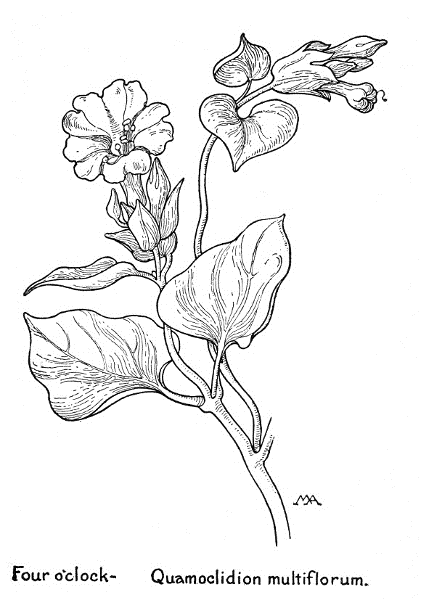
Four o'clock – Quamoclidion multiflorum.
California Four-o'clock
Hesperònia Califórnica
(Mirabilis)
Magenta, pink
Spring, summer
California
This is very common in southern California and forms quite large, low clumps of rather yellowish green, sticky and hairy foliage, sprinkled with numbers of bright little flowers, opening in the afternoon. The base is woody and the weak, hairy stems are supported on bushes, as if climbing over them. The leaves are rather thick, about an inch long, and the flowers are open bell-shaped, about three-quarters of an inch across, usually magenta, but often pink of various shades, sometimes quite pale in tint with long stamens drooping to one side, and the involucre is often purplish and very hairy and sticky. The effect at a distance is gay and attractive, though the plant is not quite so pretty close by.
Hesperònia glutinòsa var. grácilis
White, pinkish
Spring
Arizona
This has a straggling, hairy, sticky stem, over a foot long, and thickish, dull-green leaves, hairy and sticky. The flowers are about half an inch long, white or tinged with pink, and are rather delicate and pretty, though the plant is not especially attractive. It blooms at night, the flowers gradually closing with the morning sun. This variety is common in the southern part of the state, in mountain canyons, and Hesperonia glutinosa is common in the north.
There are several kinds of Abronia, all American, with branching, usually sticky-hairy stems, thick, toothless leaves, with leaf-stalks, in pairs and one of each pair somewhat larger than the other. The flowers are more or less salver-form, with five lobes, a threadlike style, and from three to five, unequal stamens, on the tube of the perianth and not protruding from it. They are numerous and in clusters, with involucres, on long flower-stalks, from the angles of the leaves. The fruit is winged. The name is from the Greek meaning graceful, but most of these plants are rather awkward in their manner of growth.
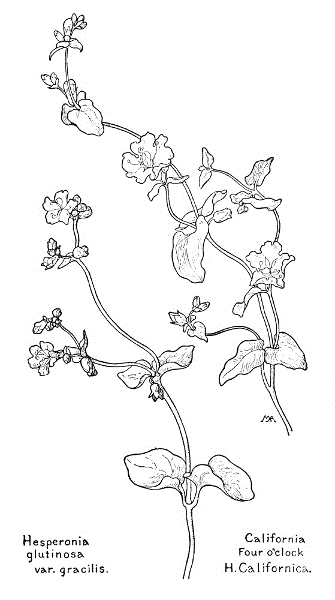
Hesperonia glutinosa var. gracilis.
California Four o'clock – H. Californica.
Sand Puffs
Abrònia sálsa
White
Spring, summer, Autumn
Utah
This plant is, as a whole, so delicately tinted and so decorative in form, that it is most attractive, particularly against the sandy soil where it grows, deserving the Greek name more than some of its slightly awkward sisters. It is about fourteen inches tall, with a stoutish, rather straggling, prostrate stem, which is pale, pinkish, sticky and fuzzy. The leaves have long leaf-stalks and are pale bluish-green, leathery and smooth, but fuzzy on the mid-vein of the under side, and the flowers are numerous, rather small, in handsome roundish clusters, which are about two inches across, with a papery, pinkish or yellowish involucre, of about five, separate, rounded bracts. The calyx is corolla-like and salver-form, with a long, yellowish or greenish tube and five lobes, prettily crinkled at the edges. The seed-vessel is very curious, resembling a round, yellowish sponge, with hooks sticking out of it, and the flowers are deliciously sweet-scented. This is sometimes called Snowball.
Pink Sand-Verbena
Abrònia villòsa
Pinkish-lilac
Summer
Ariz., Cal., Utah
The coloring of this plant, one of the prettiest of its kind, is striking and unusual, and makes it very conspicuous, growing in the sand near the sea or in the desert. The thickish leaves are light bluish-green and the thick stem, which straggles rather awkwardly over the ground, is a peculiar shade of pink and sticky and hairy, as are also the involucres. The small delicate flowers are an odd tint of pinkish-lilac, light but vivid, in striking contrast to the coloring of stems and foliage, and form very pretty clusters, with an involucre of five to fifteen papery bracts. They are very fragrant and look much like garden Verbenas, so the name is not so unhappy as some. A. umbellàta has slender stems and almost smooth leaves, sometimes with wavy margins, about an inch long, narrowed at base to a slender leaf-stalk, and deep-pink flowers. It is common all along the California coast and blooms in the summer and autumn. A. marítima is found from Santa Barbara to San Diego and is a very stout, coarse, sticky plant, with small, deep-magenta flowers.
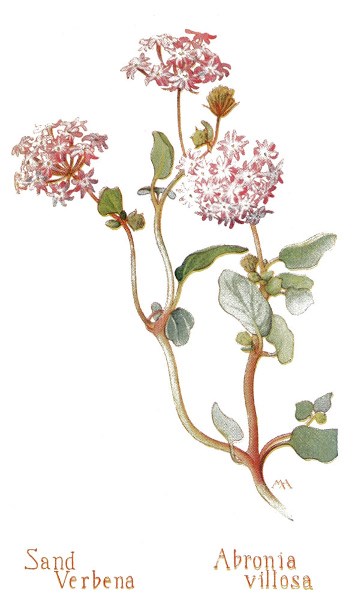
Sand Verbena – Abronia villosa.
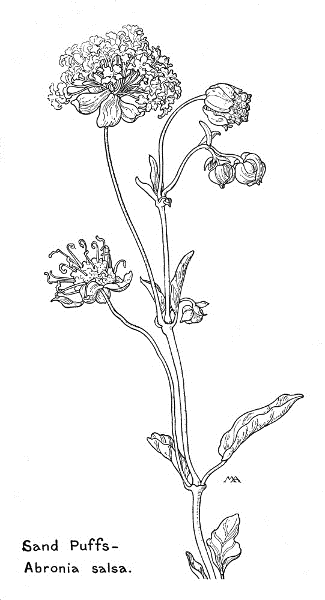
Sand Puffs – Abronia salsa.
Yellow Sand-Verbena
Abrònia latifòlia
Yellow
Spring, summer, autumn
Wash., Oreg., Cal.
Pretty at a distance, but rather coarse close by, a straggling plant, with long, thick, rubbery stems, lying on the ground, thickish leaves, and small yellow flowers, slightly fragrant and forming pretty clusters about an inch and a half across, with five bracts. This is common along the seashore, blooming more or less all through the year. It has a long, thick root, which is eaten by the Indians.
There are a good many kinds of Allionia, one Asiatic, the rest American. The bell-shaped flowers have unequal stamens, usually three, on the receptacle. The peculiar, five-lobed involucre, which becomes large and papery after flowering, contains from three to five flowers. The fruit is ribbed and often hairy. The shape of the involucre probably suggested the common name Umbrella-wort.
Narrow-leaved Umbrella-wort
Alliònia lineàris
Purple, pink, white
Summer
Utah, Ariz., etc.
A pretty plant, one to four feet tall, with a slender stem and long, narrow, bluish-green leaves, with somewhat wavy margins, and almost no leaf-stalks. The flowers are fragile and pretty, of various shades of pink, the shape of small Morning-glories, half an inch across, the stamens and style protruding. There are from three to five in a cluster, in a purple and green involucre. This involucre is curious, for before the flowers come out it is closed around a bunch of buds, looking as if it were itself a pretty five-angled bud, and one would not suspect that there were other little buds inside it. When the flowers bloom and drop, which they do very soon, this involucre unfolds and expands until it becomes an exceedingly thin, papery, five-lobed disk, three-quarters of an inch across, veined with purple, very pretty and delicate, looking like an odd little flower without a heart. The smooth stem forks towards the top and the branches, which are slightly hairy, bear numerous clusters of involucres with flowers inside them. This grows in dry soil, is widely distributed and found as far east as Illinois.

Involucre of Allionia linearis.
Yellow Sand Verbena – Abronia latifolia.

CARPET-WEED FAMILY. Aizoaceae
Not a very large family, mostly natives of warm regions. Ours are branching herbs, lying mostly on the ground; leaves mostly opposite or in whorls; flowers perfect; sepals four or five; petals numerous, small or none; stamens few or many, usually on the calyx; ovary sometimes superior; fruit a capsule. In this country most of this family are dull little plants, with inconspicuous flowers.
There are many kinds of Mesembryanthemum, mostly African; ours are smooth, very succulent perennials; without stipules; leaves opposite; calyx-lobes unequal and leaf-like; petals long, narrow and very numerous, inserted with the innumerable stamens on the calyx-tube; ovary with ten or twelve styles, becoming a sort of berry, containing many minute seeds, and opening at the top in rainy weather. The terribly long name is from the Greek, meaning "noonday flower."
Ice-plant
Mesembryánthemum crystállinum
White, pinkish
Spring
California
One of the queerest looking plants that it is possible to imagine, the stout stems and large flat leaves thickly encrusted with millions of small translucent beads, resembling glass or ice and giving a glistening effect to the whole plant. They cluster especially thickly along the wavy margins and under sides of the leaves, and on the calyxes, and feel quite hard to the touch, but when they are crushed underfoot they exude a watery juice, which is said to be alkaline and injurious to shoe-leather. The stems and leaves are light bright-green, the tips and margins tinged with bright pinkish-red, especially on dry mesas, where this plant sometimes covers the ground for long distances with flat rosettes, forming a thick, red carpet, beautiful in color. In shadier, damper places, such as the crevices in the sea-cliffs at La Jolla, it becomes quite a large, tall plant, scarcely tinged with red and very glistening. The flowers are about an inch across, with a greenish center, surrounded by numerous, small, yellowish anthers and a single row of many, white or flesh-colored petals, suggesting the tentacles of a sea-anemone. In fact the whole plant is curiously suggestive of some low form of animal life. It is very troublesome to farmers in the south near the sea, and also flourishes in the Mohave Desert, in France and the Canary Islands.

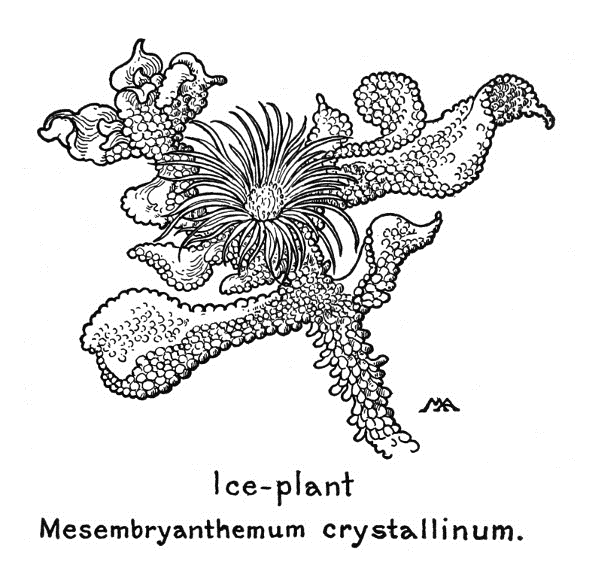
Ice-plant – Mesembryanthemum crystallinum.
Sea Fig, Fig-marigold
Mesembryánthemum aequilateràle
Pink
Spring
California
A very strange and conspicuous plant, often clothing sandy slopes with a curious mantel of trailing, fleshy stems and foliage thickly sprinkled with thousands of gaudy flowers. The stems are stout and flattish, several feet long; the leaves three-sided, with flat faces, tipped with a small reddish point; the calyx-lobes three-sided like the leaves. The stems, leaves, and the calyx-lobes are all pale bluish-green with a "bloom" and exceedingly succulent, the watery juice running out in large drops when the plant is broken. The twigs seem to be fitted into a sort of socket, from which they come out very easily, so that the plant comes apart almost at a touch. The fragrant flowers are two or three inches across, bright but crude in color, the numerous, purplish-pink petals resembling the rays of a composite and encircling a fuzzy ring of innumerable stamens, with white, threadlike filaments and small, straw-colored anthers, around a dark-green center, composed of the top of the calyx and the six to ten styles of the ovary. This accommodating plant is very useful and ornamental in hot, sandy places, where not much else will grow, and may be seen hanging its long stems over the sea-cliffs all along the coast, from Patagonia to Marin County in California. It also grows in Africa and is extensively cultivated. The fruit is edible, with pulp and tiny seeds something like a fig.
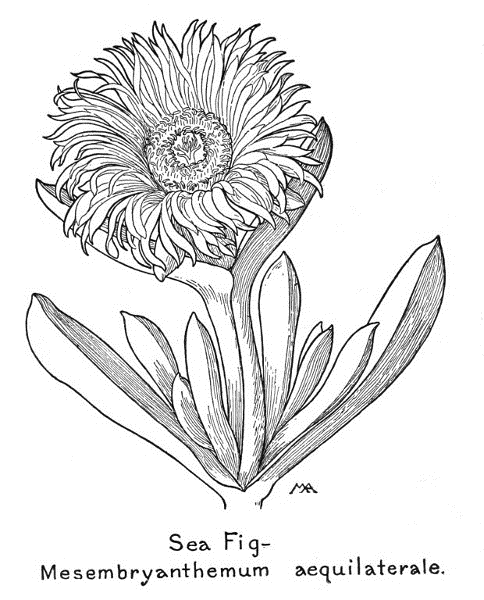
Sea Fig – Mesembryanthemum aequilaterale.
PINK FAMILY. Caryophyllaceae
A large family, widely distributed, most abundant in the northern hemisphere, including both the handsome Pinks and the insignificant Chickweeds. They are herbs, with regular, mostly perfect flowers, with four or five sepals; usually with four or five petals, sometimes with none; stamens as many, or twice as many, as the petals; ovary superior, one-celled; styles two to five in number; fruit a capsule, containing several or many, kidney-shaped seeds, opening by valves, or by teeth, at the top; leaves opposite, toothless; stems usually swollen at the joints. The name Pink comes from the petals of some kinds being cut into points, or "pinked."
There are numerous kinds of Arenaria, widely distributed, difficult to distinguish, with small, white flowers with five petals, usually not notched, ten stamens and usually three styles; leaves usually long and narrow, often stiff and growing in tufts; capsule roundish, splitting into usually three valves, each with two parts. These plants often grow in dry, sandy places, some at very high altitudes, some by the sea, hence the Latin name meaning "sandy," and the common one, Sandwort.
Fendler's Sandwort
Arenària Féndleri
White
Summer
Utah, Ariz., etc.
This has pretty little white flowers, about half an inch across, and is variable. Sometimes the stem is roughish, only three or four inches tall, springing from a tuft of small leaves, stiff and almost prickly. Sometimes the stem is smooth, six or eight inches tall, and the leaves resemble rather fine, stiff grass. This grows on dry hills and mountains, up to thirteen thousand feet, from Nebraska and Wyoming to Utah, Arizona, and New Mexico.
There are many kinds of Silene, widely distributed, more or less sticky plants, hence the common name, Catchfly; flowers mostly rather large; calyx inflated or tubular, with five teeth; petals five, with long claws, which often have scales at the top, forming a "crown"; stamens ten; styles usually three; capsule opening by three or six teeth at the tip; seeds numerous.

Sandwort – Arenaria Fendleri.
Moss Campion.
Cushion Pink
Silène acàulis
Purple
Summer
Alpine regions
An attractive little dwarf, living only in the high mountains. It has a long tap-root and many spreading stems, crowded with tiny, stiff, pointed, dark-green leaves, forming close tufts, from six to twenty inches across, resembling cushions of harsh moss and spangled all over with pretty little flowers. They are less than half an inch across with a bell-shaped calyx and five bright pinkish-purple petals, occasionally white, with a "crown" of small scales. We find this brave little plant crouching on bleak mountain tops, blossoming gayly at the edge of the snows that never melt, in arctic alpine regions across the world, up to a height of thirteen thousand feet. It is variable. There is a picture in Mrs. Henshaw's Mountain Wild Flowers of Canada.
Windmill Pink
Silène Ánglica
(S. Gallica)
White
Spring
Northwest, etc.
A rather inconspicuous "weed" from Europe, common in fields and along roadsides, with a slender, hairy stem, about a foot tall, and hairy leaves. The small flowers grow in a one-sided cluster and have a purplish calyx, sticky and hairy, and white or pinkish petals, with a small "crown," each petal twisted to one side like the sails of a windmill. This is widely distributed in nearly all warm temperate regions.
Indian Pink
Silène Califórnica
Red
Summer
Northwest
From six inches to over a foot tall, with a thick, perennial tap-root, one to two feet long, and branching, half-erect stems, both leaves and stems covered with fine down, the dull-green foliage contrasting well in color with the vivid vermilion of the gorgeous flowers. They are more than an inch across, the petals usually slashed into two broad lobes, flanked by two narrower, shorter points at the sides, the "crown" conspicuous. The flowers are even more brilliant in color than S. laciniata and are startlingly beautiful, glowing like coals of fire on the brown forest floor, in the open mountain woods they usually frequent. It is widely distributed in the Coast Ranges and Sierra Nevada Mountains, but nowhere very common. S. Hookeri has beautiful large pink flowers, often more than two inches across, sometimes white, and grows on shady hillsides in the Northwest, except in Idaho.
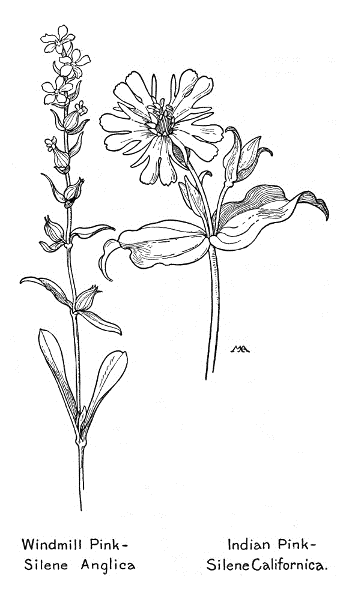
Windmill Pink – Silene Anglica.
Indian Pink – Silene Californica.
Indian Pink
Silène laciniàta
Red
Summer
California
This has handsome conspicuous flowers, clear vermilion or pinkish-scarlet in color, about an inch and a half across, with the five petals prettily slashed at the ends into four long divisions. Each petal has two little crests, which form a pretty "crown" in the throat of the corolla. The roughish, slender stems, from one to over two feet high, have several branches, the flowers growing two or three at the ends. The leaves are long, narrow, and rather rough and the whole plant is hairy and sticky. This is common around Pasadena and other places in southern California and is beautiful on Point Loma, where the brilliant flowers gleam among the underbrush like bits of flame. S. laciniàta var. Gréggii is common in Arizona and New Mexico.
Silène Lyalli
White
Summer
Northwest
Rather pretty, with a slender stem about a foot tall, smooth, bluish-green leaves, and flowers about three-quarters of an inch across; the calyx much inflated, yellowish-white and papery, with brownish veins, and the petals cream-color, with two lobes and a "crown."
There are a few kinds of Vaccaria, of Europe and Asia, smooth annuals, with clasping leaves and red or pink flowers in terminal clusters; calyx five-angled and inflated in fruit, five-toothed, without bracts; petals longer than the calyx, without appendages; stamens ten; styles two. Both the Latin and common names allude to the value of some kinds for fodder.
Cow-herb
Vaccària vaccària
(Saponaria)
Pink
Summer
Across the continent
Quite pretty, with a leafy, branching stem, from one to three feet tall, bluish-green leaves, and flowers less than an inch long, with a ribbed, yellowish-green calyx, with reddish teeth, and the petals a very pretty and unusual shade of deep, warm reddish-pink, veined with deeper color. This is a European "weed," common in waste places and cultivated fields.
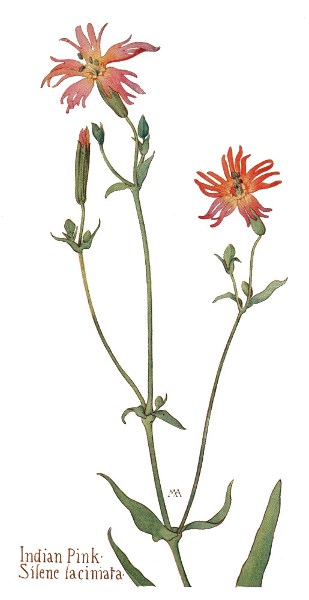
Indian Pink – Silene laciniata.
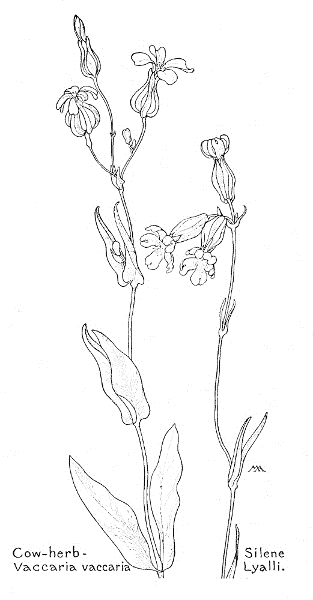
Cow-herb – Vaccaria vaccaria.
Silene Lyalli.
There are many kinds of Alsine, widely distributed, low herbs, liking moist ground and shady places, with small, starry white flowers; with four or five sepals; four or five petals, deeply two-lobed or none; three to ten stamens and three to five styles; capsule roundish or oblong, rather shorter than that of Cerastium, splitting to below the middle, with twice as many valves as there are styles and many seeds. Many of these plants are weeds. They are often called Stitchwort. The Greek name means "grove," the home of some kinds.
Tall Chickweed
Alsìne lóngipes.
(Stellaria)
White
Summer
Northwest, Nev., Utah, etc.
An attractive little plant, with smooth stems, from six to fifteen inches tall, and pretty little flowers, less than half an inch across, growing singly, or in loose clusters, with white petals which are deeply two-lobed, so that they appear to be ten. The capsule is almost black when ripe. This is common in moist and grassy places in Yosemite and when growing in the shade is taller and more slender than in the open. It reaches an altitude of ten thousand feet and is found in the East and in Asia.
There are many kinds of Cerastium, abundant in the temperate zone, resembling Alsine, but usually downy and therefore called Mouse-ear Chickweeds. The flowers are white, usually with five sepals, five petals notched at the tips or with two lobes, ten or five stamens and five stigmas. The cylindrical capsule, often curved, splits at the top into ten teeth.
Field Chickweed
Cerástium arvénse
White
Spring, summer
U. S.
On the ledges moistened by the mist and spray that blow from the Yosemite waterfalls, among the glistening, wet grasses, these pretty little white flowers are quite conspicuous. They smell pleasantly of honey, measure about half an inch across, and have more or less downy stems, from five to ten inches tall. This is the prettiest Cerastium, though not so "mousy" as some, and grows in dry as well as moist situations.
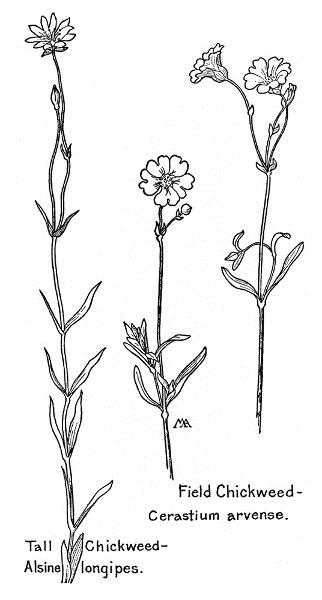
Field Chickweed – Cerastium arvense.
Tall Chickweed – Alsine longipes.

PURSLANE FAMILY. Portulacaceae
A rather small family, mostly American; herbs, usually with thick, succulent leaves and stems, with flowers opening only in sunlight. They usually have only two sepals, but the petals number from two to five or more; the stamens are sometimes numerous, but when they are of the same number as the petals they are opposite them; the one-celled ovary is superior, becoming a many-seeded capsule. Pusley, or Purslane, is one of the commonest garden weeds; everybody knows how difficult it is to keep the spreading rosettes out of gravel walks, and we are all familiar with the gaudy, ephemeral flowers of the cultivated Portulaca. The Purslane-tree, or Spek-boom, of South Africa is often the principal food of elephants and its foliage gives the characteristic coloring to the landscape.
There are several kinds of Montia, closely related to Claytonia, mostly natives of North America, rather succulent plants, very smooth and often with a "bloom." The flowers are white or pinkish, with two sepals; the five petals, equal or somewhat unequal, separate or more or less united at base; the stamens five or three; the style branches three; the capsule with three valves and one to three, shiny, black seeds, which when ripe are shot out of the capsule by the elastic closing of the valves.

